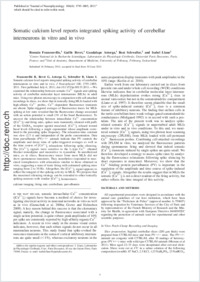Somatic calcium level reports integrated spiking activity of cerebellar interneurons in vitro and in vivo
- Franconville, Romain Centre National de la Recherche Scientifique, Laboratoire de Physiologie Cérébrale, Université Paris Descartes, Paris, France
- Revet, Gaëlle Centre National de la Recherche Scientifique, Laboratoire de Physiologie Cérébrale, Université Paris Descartes, Paris, France
- Astorga, Guadalupe Centre National de la Recherche Scientifique, Laboratoire de Physiologie Cérébrale, Université Paris Descartes, Paris, France
- Schwaller, Beat Unit of Anatomy, Department of Medicine, University of Fribourg, Switzerland
- Llano, Isabel Centre National de la Recherche Scientifique, Laboratoire de Physiologie Cérébrale, Université Paris Descartes, Paris, France
-
06.06.2011
Published in:
- Journal of Neurophysiology. - 2011, vol. 106, no. 4, p. 1793-1805
English
We examined the relationship between somatic Ca²⁺ signals and spiking activity of cerebellar molecular layer interneurons (MLIs) in adult mice. Using two-photon microscopy in conjunction with cell-attached recordings in slices, we show that in tonically firing MLIs loaded with high-affinity Ca²⁺ probes, Ca²⁺-dependent fluorescence transients are absent. Spike-triggered averages of fluorescence traces for MLIs spiking at low rates revealed that the fluorescence change associated with an action potential is small (1% of the basal fluorescence). To uncover the relationship between intracellular Ca²⁺ concentration ([Ca²⁺]i) and firing rates, spikes were transiently silenced with puffs of the GABAA receptor agonist muscimol. [Ca²⁺]i relaxed toward basal levels following a single exponential whose amplitude correlated to the preceding spike frequency. The relaxation time constant was slow (2.5 s) and independent of the probe concentration. Data from parvalbumin (PV)−/− animals indicate that PV controls the amplitude and decay time of spike-triggered averages as well as the time course of [Ca²⁺]i relaxations following spike silencing. The [Ca²⁺]i signals were sensitive to the L-type Ca²⁺ channel blocker nimodipine and insensitive to ryanodine. In anesthetized mice, as in slices, fluorescence traces from most MLIs did not show spontaneous transients. They nonetheless responded to muscimol iontophoresis with relaxations similar to those obtained in vitro, suggesting a state of tonic firing with estimated spiking rates ranging from 2 to 30 Hz. Altogether, the [Ca²⁺]i signal appears to reflect the integral of the spiking activity in MLIs. We propose that the muscimol silencing strategy can be extended to other tonically spiking neurons with similar [Ca²⁺]i homeostasis.
- Faculty
- Faculté des sciences et de médecine
- Department
- Département de Médecine
- Language
-
- English
- Classification
- Biological sciences
- License
- License undefined
- Identifiers
-
- RERO DOC 28189
- DOI 10.1152/jn.00133.2011
- Persistent URL
- https://folia.unifr.ch/unifr/documents/302310
Statistics
Document views: 88
File downloads:
- sch_scl.pdf: 139
